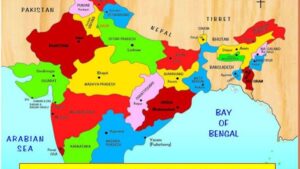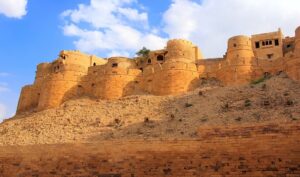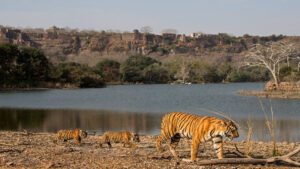
India is a very big country with 29 states and 7 association areas. According to data from 2011, Rajasthan is India’s largest state.
Rajasthan covers an area of about 3,42,238 square kilometers and is in the northwest of the country. It makes up 10.41% of all of India. When it comes to its physical zone, the state is like the European country Germany.
Even though it is the largest in the region, it is only the seventh largest in terms of population. It was made when Rajputana joined the Dominion of India in 1949. Jaipur is its center and largest city. The cities of Udaipur, Ajmer, Bikaner, Kota, and Jodhpur are also very important. the biggest Indian state
It covers 132,139 square miles (342,239 square km).
68,621,012 people live there.
Jaipur is the capital.
Location:
The state of Rajasthan is in the northwest of India. It is in the northwest of the Indian region. The weather in Punjab and Haryana stops it from going further north and east. In the direction of Uttar Pradesh and Madhya Pradesh to the east and southeast. The state of Gujarat is to the southwest, and the Pakistani states of Sindh and Punjab are to the west and northwest. The state’s capital is Jaipur, which is in the eastern part of the country. the biggest Indian state
History:
Rajasthan, which means “The Home of the Rajas,” used to be known as Rajputana, which meant “The Land of the Rajputs.”
Before 1947, when India got rid of British rule, it was made up of about twenty royal states and chiefdoms, the small area of Ajmer-Merwara that was governed by the British, and a few spots of land that weren’t in the main areas. the biggest Indian state
The August states and chiefships became part of India in stages after 1947. The state was then called Rajasthan. With the passing of the States Reorganization Act on November 1, 1956, it became the state it is today. the biggest Indian state
Places to Visit in Rajasthan:
Rajasthan is one of the most popular tourist destinations to see Indian history and culture up close. To be able to see how good the state is, two weeks should be enough time. There are many natural and man-made trip goals in the area, such as:
Amber Fort in Jaipur:
The Amber Fort in Jaipur was the home of the Kachhawaha group before Jaipur was built. It is located 11 km away from the city of Jaipur. This job was held by Raja Man Singh I. in 1952. This hallway has beautiful carvings and moment mirror work. the biggest Indian state
There are a few lobby areas and buildings in the Amber Fort that have really cool features. The best thing about this Fort as a holiday spot is that it is on a steep slope and has a royal elephant ride.
The Amer Fort is a traditional part of Jaipur and its grandeur. Going on a trip to Jaipur would not be complete without seeing Amber Fort.
Camel Fair in Pushkar:
The Pushkar Camel Fair, also known as Pushkar Mela, is one of the biggest and most well-known events in India, which is saying a lot. It takes place in the middle of nowhere, away from the busy towns of Rajasthan.
A huge number of camels, ponies, and dairy cows slip and slide on the sandhills of Pushkar, where they are bought and sold by locals and tourists. Ranchers and farmers have to go on a lot of business trips to this fair, which is an alien event with huge effects.
Chittorgarh Fort:
The Chittorgarh Fort is spread out over 700 acres of land on a 180-meter (590-foot) steep hill. It is about two hours northeast of Udaipur, which is in the southern part of the state of Rajasthan. This is a great spot to visit close to Chittorgarh. The slope and castle are set up next to the Gambhir River, which makes the view even more beautiful.
Mehrangarh Fort in Jodhpur:
Visit the Mehrangarh Fort in Jodhpur. The Mehrangarh Fort is the most famous landmark in Jodhpur because of its beautiful design and interesting past. Mehrangarh fortification was built by Rao Jodha in 1459 and is thought to be one of the most amazing and beautiful posts in Rajasthan. The post is on a 125-meter-high hill on the edge of Jodhpur city and covers 5 km of land.
Junagarh Fort in Bikaner:
In Bikaner, there is a great building called the Junagarh Fort. It is where the city of Bikaner grew up. At first, the fort was called Chintamani. In the 20th century, it was changed to Junagarh, which means “Old Fort.” In 1478, Rao Bika worked to build the stronghold of Junagarh.
The amazing Junagarh Fort still stands as a symbol of building light in all its grandeur. A lot of people come from all over the world to see these beautiful buildings at this fortress.
The Lake at Pichola in Udaipur:
Going to Udaipur and not taking a boat ride on this lake is like committing a crime. Pichola Lake is one of the oldest and most beautiful lakes in Udaipur. It is known all over the world for its pleasant beauty and beautiful surroundings. One of the best places to see in Udaipur is this.
In his 1899 book Letters of Marque, Rudyard Kipling wrote about this lake: “If the Venetian owned the Pichola Lake, he may state with equity, see it and kick the bucket.” As soon as you see this lake, you’ll fall deeply in love with it.
Taragarh Fort in Bundi:
Taragarh Fort is a huge piece of architecture that is located in the Bundi area. It was built in the 1600s and is sometimes called Star Fort. Inside the walls are huge stores made from Strong Shake and the Bhim Burj, which is where a famous gun is built.
It was built at a height of 1,426 feet and now holds a very prestigious painting show. This is where the Bundi style of wall painting got its start.

Jaisalmer Fort:
The Jaisalmer Fort is an important landmark in the city of Jaisalmer. It was built out of sandstone and is located in the same name.
The barrier was built in 1156 and is a proud possession of the Bhati group. His name was Rawal Jaiswal, and he built Jaisalmer City and made it stronger while he was in charge. It is a stronghold that is 250 feet high and has walls that are 30 feet long.
There are 99 bastions in the defense. Between 1633 and 1647, 92 of them were worked on. The design is a mix of Islamic and Rajput styles.
There are four ways to get into this fortress. They are Ganesh Pol, Akshaya Pol, Suraj Pol, and Hawa Pol. The Jaisalmer Fort is on Trikuta Hill and has been the site of many battles.
The Desert Scenery in Jaisalmer:
In Jaisalmer, one of the most popular outdoor activities is a ride through the Sand ridges (At Sam). If you want to enjoy this trip, Chetram Voyages has three exciting packages for a Jaisalmer Desert Tour. These are
The Jal Mahal in Jaipur:
Maharaja Madho Singh I used the Jal Mahal as a hotel for his duck-chasing parties. It is clear from the Mahal how close the Rajputs and the Mughal Empire were to each other. The engineering of the royal home is a mix of the two types of buildings.
A lot of different Maharajas improved the house over the years. Maharaja Jai Singh II, for example, made the royal home even better by adding plant enclosures that made the Jal Mahal more pleasant. After a long time of coming up with new ideas, we now have the wonderful “water castle.”
The Pink City in Jaipur:
Jaipur is India’s most organized city, and it has a long history of kings who lived in wonderful palaces and forts. In any case, that’s not the only thing that makes the city of Rajasthan famous.
There is a very interesting story behind the color pink that covers the whole city of Jaipur. Here’s everything you need to know about the “Pink Paint Culture” of one of the friendliest cities in the world.
Umaid Bhawan in Jodhpur:
Umaid Bhawan is the source. The bright yellow sandstone Umaid Bhawan Palace in Jodhpur is one of the most famous homes in the world and a symbol of the city’s honor and affection. Visitors get to see what it was like to be a master.
The Maharaja used to stay in those rooms. from wonderful activities like croquet or polo. From above, you can see the gardens of the royal house and the explosive Mehrangarh Fort. The themed meals are one-of-a-kind and show off all the beauty and magic of the desert country.
This is Khejarla Fort in Jodhpur:
In the desert sands of Rajasthan, you can find amazing hidden secrets, and many of the cultures that have grown over hundreds of years are still very much alive. The Khejarla Fort in Jodhpur is a historic site that should be respected.
In the past, it served as a wall around the city. Now, it’s been used as a record store that has helped historians and archaeologists learn a lot about Indian history. The fortress displays Rajput and Mughal architectural styles and makes people admire its exceptional beauty, even though the outside is broken and old.
Dilwara Temples in Mount Abu:
The Dilwara Temple is the most beautiful place for Jains to go on a trip. It is set in the middle of the lush green Aravalli slopes of Mount Abu in Rajasthan. Vastupal Tejpal planned this refuge, and Vimal Shah built it between the 11th and 13th centuries. It is famous for the large amount of marble used and the random carvings on every nook and cranny.
Even though the Dilwara Temple doesn’t look very interesting from the outside, the structures and designs cut into the roofs, walls, tunnels, and columns will blow your mind when you enter.
Mirpur Jain Temple in Sirohi:
There is a Mirpur Jain Temple in Sirohi. It was built in the ninth century AD, when the Rajputs were in charge. Most people think that the Mirpur sanctuary is Rajasthan’s most well-known marble attraction.
It is given to Pārźva, the 23rd Jain Tirthankara. In the 13th century, Mahmud Begada destroyed the shrine. In the 15th century, it was rebuilt and improved.
These days, only the main shrine with its mandapa is left. It stands tall on its platform, which has cut columns and engraved parikrama that show different parts of Indian mythology.
Keoladeo Bird Sanctuary:
The Keoladeo National Park, which used to be called the Bharatpur Bird Sanctuary, is thought to be one of the best places in the world for birds to breed and grow.
In the 1850s, it was first used as a royal chase hold and was a safe place for Maharajas and the British to hide. Lord Linlithgow was Viceroy of India from 1936 to 1943. In fact, he and his following party killed more than a lot of ducks in a single day. After being named a national park in 1982, Keoladeo was later named a UNESCO World Heritage Site in 1985.
At the leisure center, you can find more than 370 different kinds of birds and animals. These include the peaceful python, painted storks, deer, nilgai, and many more. The famous Indian biologist and ornithologist Salim Ali used his fame to get the government to support making Keoladeo National Park.
It was also known as the breeding place for the rare and hard-to-spot Siberian crane. Keoladeo National Park has well-marked trails that can be reached on foot, by bike, or by rickshaw. In fact, the leisure center management has taught the rickshaw pullers how to spot birds, and they are very knowledgeable helpers.
Mount Abu:
The Aravallis didn’t look like they were called that at any other time. Every time someone visits, the winding streets that lead to Mount Abu Hill Station, which is Rajasthan’s main ski resort, look like a dream. This is a great hill station close to Jaipur. Along with that, nothing beats the cool breeze of a much-desired slope town over the hot cities that are shrinking and being left empty.
Anyone who has been to Mount Abu can fully understand what dawn looks like and how dusk can scare people who don’t seem important. All of these meanings and more come from the choice to visit the state of reality. the biggest Indian state

Ranthambhore National Park:
The Ranthambhore National Park is home to a sanctuary for wild animals. It was opened in 1957 as the Ranthambore Natural Life Asylum. This park was given the name “Tiger Reserve” in 1974. There are a lot of bodies of water inside the leisure center that guests can easily see. This is the perfect place for animals to relax in the late spring.
In 1955, Sariska was named a place where wildlife could thrive, and in 1979, it became a national park. The leisure center is famous for two things: the wild animals that live there and the real landmarks and safe places. the biggest Indian state
The National Park and Tiger Reserve at Sariska:
The Sariska Tiger Reserve is in the district of Alwar in the Indian state of Rajasthan. It covers an area of 866 km2 (334 sq mi), which has rough hills, scouring thorn-arid forests, and dry deciduous backwoods. This area was a hunting preserve for the state of Alwar, and in 1955 it was named a wildlife preserve. the biggest Indian state
It became a tiger hold, which meant it was part of India’s Project Tiger in 1978. The Natural Life Sanctuary became a national park in 1990, and it covers an area of about 273.8 km2 (105.7 sq mi). It is the only place on Earth where tigers have been successfully moved.
Site Mata Wildlife Sanctuary:
The Site Mata Wildlife Sanctuary is in the Pratapgarh area of the northwest Indian state of Rajasthan. It is an area with a lot of plants, including Gulmohar, Sindoor, Rudraksha, Bamboo, Bel, and other trees that lose their leaves in the fall. Botanists have found 108 healing herbs in the haven, with about 17 of them being in danger of going extinct.
A Hindu story says that the Valmiki Ashram was in this forest. This is what the Sitamata Wildlife Sanctuary is called. There is also a temple in the area dedicated to Goddess Sita.
Scientists studying the past have found a few rocks with images of long-ago animals. In this way, the asylum is also seen as having a huge real-life importance.